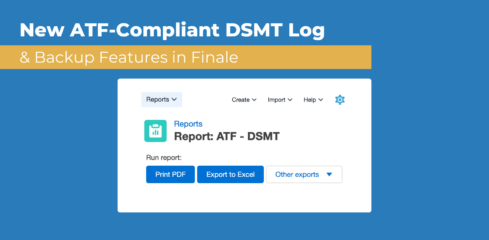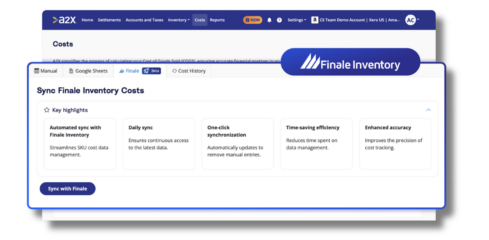Square Inventory Management: How to Gain Visibility and Prevent Overselling for Offline and Online Sales

Successful business owners know that inventory is one of the most important aspects of their business. When inventory management is done well, it can make all the difference between a thriving and a failing business. Inventory is important because it is what customers will interact with most. Product listings should reflect when products are in stock and available. As long as you enter the correct data, customers benefit from a tightly run ship and can get their orders without a headache or problem. This is known as proper inventory management.
When numbers aren’t accurately reflecting your inventory, items and products get misplaced and customers have to wait longer for their orders. Proper inventory management is clearly important, and there’s more to it than just staying on top of your numbers. Inventory visibility and the prevention of overselling are critical for functional inventory management. These two factors can help your business grow in profits, lower costs and customer loyalty.
Many small business owners leverage Square as their Point of Sale (POS) to conduct payment transactions in their brick-and-mortar stores. Experienced sellers know the importance of expanding their business into the online market to gain more sales.
However, selling on multiple channels requires a centralized inventory management solution like Square to seamlessly manage inventory and prevent overselling, especially on online channels like eBay and Amazon. It’s essential to keep a firm grasp on your inventory as you add new selling channels to keep up with increased sales.

Understanding Inventory Visibility
A lack of inventory visibility results from using disparate systems and technology to manage orders and inventory. In addition, using poor systems can also result in steep costs, decreased profits and damaged customer loyalty. When inventory information is not accurate, timely or complete, it becomes difficult to manage an inventory landscape of your warehouses, online and brick-and-mortar stores.
In fact, the only way to accurately and efficiently achieve “end-to-end” inventory visibility is by syncing your business up with a single, centralized order and inventory management solution. When you implement an inventory management solution, it can make all the difference between success and further inventory-related problems.
How to Gain Visibility
When it comes to the “perfect order,” this simply means that your business delivers the right products and services at the very best price when and where your customers want them. In other words, you can serve your customers better than the competition. When you’re able to achieve the perfect order, you can rest easy knowing that you are operating an efficient and thriving business that delivers what its customers want and expect. They can buy what they want and receive the right product for a great price in a timely manner. A proper inventory management system is the best place to start to provide your customers with the services they want and deserve.
The right inventory management software solution will streamline all operations thanks to integrations and cloud storage technology so that order and inventory information is up to date across all channels and marketplaces. You’ll have access to a single, enterprise-wide view of your collective inventory so that you can optimize business decisions that will please your customers and meet their needs.
A proper software solution will notify you when certain products are low, when specific products are selling well and when they aren’t, when demand trends change, which products need to be reordered straight away and which can wait a bit since they aren’t selling as quickly. All this information gives you an advantage over market demand so that you can cater to your customers and fulfill their needs without missing a beat.
Using this level of inventory visibility gives you real-time order and inventory information so that you always know what your numbers and stock levels are. All this information can help you keep things flowing in every channel you’re using.
Finally, when your business fulfills customer orders accurately, efficiently, and in a timely manner, it improves customer loyalty. Customers are more likely to shop with you again as well as spread the word on your business and products, which can lead to higher sales over time.
Square Inventory Management: What Happens When You Oversell
Another part of inventory management to think about is how much you are selling. Of course, high sale rates are great, but they can be damaging under a certain condition: overselling, or selling more of a product than you have. This happens when your product numbers are inaccurate, which means the amount of a product listed online does not reflect what’s actually in your warehouse inventory.
What Overselling Means
Selling products you don’t actually have is known as overselling. Overselling can be detrimental to your business because it can break customer trust and loyalty, cost you money over time and generate negative reviews on your product listings. Your products might rank lower on search engine results pages (SERPs). Even worse, not addressing habitual overselling will eventually result in being banned from selling on Amazon, eBay, Walmart and other large marketplaces.
The Causes of Overselling
Understanding the root cause of the issue is key to learning how to solve it. Overselling can occur for a number of reasons, including:
- Discrepancies between stock on hand and recorded numbers
- Damaged inventory
- Sudden changes in demand for certain products
- Lack of synchronization across all sales channels
- A combination of any of the above
The ultimate reason behind overselling is a lack of communication within your system. When one storefront reflects incorrect stock levels, it can affect your whole system. Fortunately, overselling is a preventable situation. Effective inventory management strategies will help you stay up-to-date on your stock levels so your business can run smoothly.
How to Prevent Overselling for Online Sales

Preventing overselling begins with your inventory. Poor inventory management systems make it difficult to know your accurate stock numbers. This means that product records for both your online and offline stores will be inaccurate, which can lead to issues when customers start placing orders. To prevent overselling for online and offline sales, you first have to get your inventory in order with an excellent inventory management software system. Once you’ve done that, you should follow up with these strategies:
Invest in Inventory Management Software
You’re not just picking an inventory management software system — you’re investing in one. When you invest in an online inventory tracker and management software that works well, comes with integration features and streamlines your inventory operations, you’re really taking care of inventory management and your business for the long haul.
Inventory management is the first step to being able to keep accurate, real-time inventory data, improve sales and customer loyalty and accurately forecast demand. Some inventory systems are better than others, so do your research before you start shopping for what works best for you and your business.
Set Standard Levels
The standard level of a product refers to the minimum quantity of the product that you have on hand at all times. For example, you may make a rule to have 50 coffee makers on hand at all times to take care of orders for this specific product. When your stock falls below the standard level, you know it’s time to reorder more inventory.
In addition, when you place an order for more inventory, you should also order the minimum amount – your standard– so that you put the product above the standard level. To come up with a good standard level, think about how quickly the item sells and how long it takes to receive replacement inventory from your suppliers.
You’ll also want to keep track of your inventory by scheduling regular audits. That’s easy to do when using an inventory management software system that provides accurate reports on inventory levels and other pertinent data. Conduct an audit using the following methods:
- Conduct yearly physical inventory counts: Counting all your inventory at once, like during a yearly audit, is one way to manage your inventory. However, this method is most effective when combined with others because it’s time-consuming and less accurate when done on its own.
- Perform regular spot checks: By checking on specific products at certain times throughout the year, you’ll have a better idea of what your counts should be at the end of the year. Plus, regular checks mean you’re more likely to catch irregularities, like damaged or destroyed products, sooner.
- Implement a cycle counting schedule: Count designated products throughout the year in an order that makes sense for your warehouse. Like with spot-checking, keeping to a logical cycle counting schedule can make your yearly audits much easier.
- Establish a First-In-First-Out (FIFO) rule: Fulfill orders using your oldest inventory first. The FIFO method is another way to account for any damaged or destroyed inventory so you can get it off your shelves. You’ll also ensure that available inventory is in good condition, which will positively affect customer satisfaction.
- How to Prevent Overselling for Offline Sales
Out-of-stock management is just as important in brick-and-mortar stores as it is when selling online. An offline POS system is one that does not connect to the cloud and only reflects the inventory level of one location. That’s why an offline POS can be an effective strategy for small, localized businesses. A few reasons sellers may choose an offline POS system include:
- Easy tracking of stock in real-time
- Fast transactions
- The ability to continue business without the internet
Of course, if your business has multiple locations or you plan to juggle online and offline stores, your best strategy would be to use a cloud-based online POS system like Square. When considering an online vs. offline POS, here’s why you should opt for an online system:
- Synchronization across all sales channels
- Increased stock visibility
- Improved customer experience
- Automatic data entry
- Maximized sales
- The ability to launch promotions and discounts across multiple platforms
Overall, an online POS system is more advantageous for both online and offline sales because it can automatically update all of your channels. You’ll need to do some research to figure out which specific system would work best in your business, but in the long run, integrating an online POS system into your inventory management strategy can significantly boost your efficiency and sales.
When you gain visibility for your inventory and prevent overselling both offline and online, you’re reaching an important level of Square inventory management. Remember, proper inventory management is what makes a business work, so be sure to do all you can to manage your inventory accurately and efficiently at all times.
Contact Finale Inventory for More Information
If you’re searching for an excellent inventory management system, Finale Inventory has you covered. Our cost-effective, cloud-based inventory management software has full barcode integration and works well with any record-keeping software, like Excel, QuickBooks or Square. Having an optimized inventory strategy will allow you to focus on growing other aspects of your business.
Interested? Fill out our online contact form today for more information or call us at 888-792-8891.




